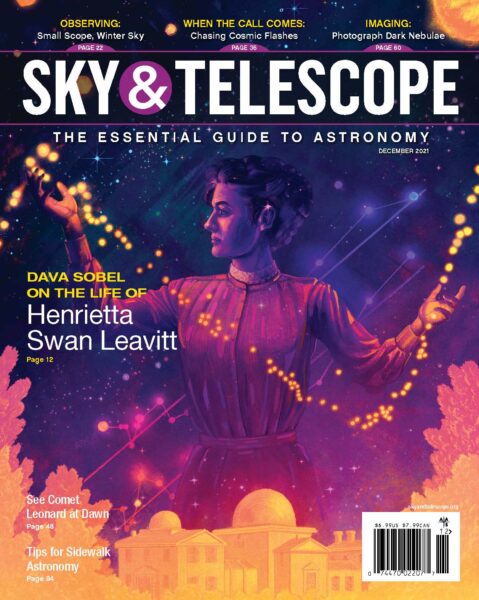
Henrietta Swan Leavitt, Dark Nebulae, and Magnetars
In the December 2021 issue of Sky & Telescope, we’re discussing the life and accomplishments of the woman who set the stage for modern astronomical research. We follow her story from the events that led to her career at Harvard College Observatory and her discovery of the correlation between the period and luminosity of Cepheid variable stars that made it possible to calculate their distance from Earth. We’re also taking a look at a different kind of star: magnetars. We cover the hunt for these unusual neutron stars, which have extreme magnetic fields and produce gamma-ray flares. Then, astronomers are keeping an eye on the sky and on their phone notifications in hopes of catching a gravitational-wave merger. Plus, we’re looking out for the little guys this issue — little telescopes, that is — with a tour through the winter sky tailored specifically for scopes with focal lengths of about 480 mm to 700 mm.
FEATURE ARTICLES:
Remembering Henrietta Swan Leavitt
How one talented astronomer’s meticulous work left an important legacy.
By Dava Sobel
Wander through winter skies and take in the delightful objects December nights offer.
By Brian Ventrudo
The Short, Violent Lives of Magnetars
Neutron stars with extreme magnetic fields are behind some of the brightest outbursts in the Milky Way. Their story might reveal the answers to many cosmic mysteries.
By Matthew R. Francis
Astronomers drop everything to look for flashes from gravitational-wave mergers, but often their searches turn up empty.
By Jure Japelj
These thick clumps of gas and dust make excellent targets for astro-imagers.
By Ron Brecher
Beyond the Printed Page:
Read about the life and work of Carolyn Shoemaker.
Check out this catalog of luminous stars in the Andromeda and Triangulum galaxies.
See the Move-Shoot-Move Tracker from Alan Dyer’s review in action.
Use Sky & Telescope’s Pocket Sky Atlas to navigate your way around the sky.
ALSO IN THIS ISSUE:
One of the sky’s finest open clusters has quite a tale to tell.
By Fred Schaaf
Comet Leonard Races Across the Sky
This fast-moving visitor may prove to be the best object of its kind in more than a year.
By Bob King
Understanding the Moon requires looking beyond the visible.
By Charles Wood
Producing high-quality astrophotos with a digital camera means understanding a few key parameters.
By Richard S. Wright, Jr.
Table of Contents
See what else December's issue has to offer.
 0
0

Comments
You must be logged in to post a comment.